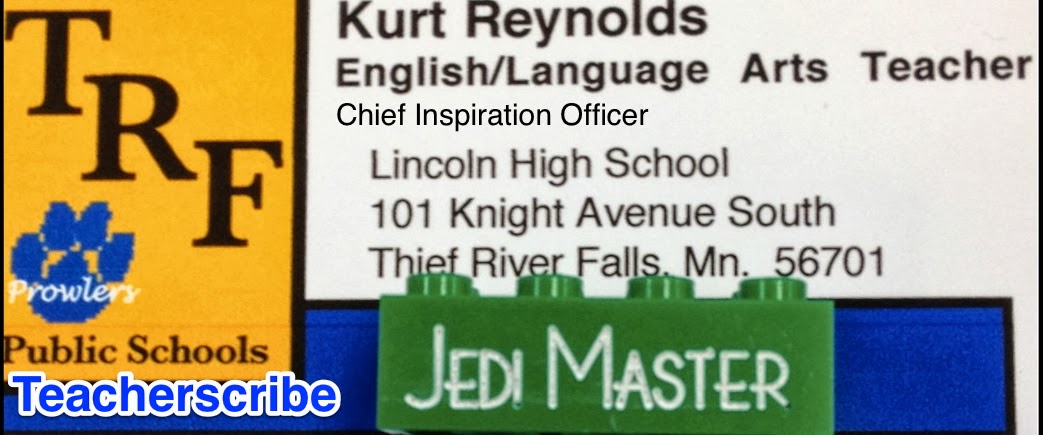2. What simple tools are available to me to help personalize instruction.
This is one is easy: social media.
First, I distribute my cell phone number to students. How does this personalize instruction? Well, students today - I have found anyway - are so hyper busy in their lives that they don't fit homework into a neat 9-10:30 window, as I did when I was their age.
On any given day, I will get a text from a student at 4:00 with a question (no joke. I usually help them and then give them a hard time about being a total nerd and asking them who does their homework at 4 in the afternoon? They respond, that they are getting it done before they leave for a six hour shift). Then I'll get another text half an hour late from another student who is on a bus to a game and has a question. Then at 7 I'll get a text from a student who just got home from practice and wants to run an idea by me.
This continues until I go to sleep. In fact, this was what one of my students spoke about at the Honor's Banquet. He had a works cited question and shot me a text at 11:30, hoping beyond hope that I'd respond. He said he was shocked that I responded in less than a minute. He added that there was no doubt after that about how much I cared about my kids.
And caring, I feel, is the first key in personalizing instruction.
Second, Twitter. I think some people really think that what students put on Twitter is just about having sex and drinking. And I know they'd be amazed that that's not true. Yes, they put stupid things up on there, but it's usually whiny stuff about Mom and Dad or their teachers (yes, if you have a child with a smart phone, you have a child who has Tweeted something negative about you. Yes, gasp, shock, awe! My step-daughter tweeted something negative about her parents (we were not in the wrong - and we had a great conversation about this matter shortly after) and twice by students (and - to be fair - they were justified in blasting me both times!).
But it also gives us a window into their worlds that allows us to see their hopes, passions, frustrations, and interests. Don't tell me that those things can't be used to personalize instruction.
Third, various other sites: padlet (formerly wallwisher), Google Docs, polleverywhere, surveymonkey, easely.ly, Collaborize Classroom, Blogs, Blubbr . . .
Here is a simple way I use padlet to personalize instruction -
This is in response to the first section of Seth Godin's Linchpin. This allows students to take a topic (this example is on finding something one they consider to be remarkable) and then posting a video or story or image that illustrates this. We will spend an entire block watching these and then giving each student a chance to justify their post.
What's the importance of personalizing instruction?
Well, it means something to students. Okay, to most students.
Read Teach Like a Pirate to see this in action. But no kid really gets fired up by an assignment or worksheet that they can tell the teacher printed out of a curriculum binder.
Sorry.
It zaps their enthusiasm.
But if you give them something personalized or individualized that you concocted on your own? I believe (and maybe I'm way off here) it has a greater connective factor.
Personalizing instruction helps build the culture of your classroom. And one of the best things I've heard is this line - "culture eats strategy for lunch."
You can walk through the cookie cutter curriculum offered by textbook companies, but if you don't personalize it and get it to meet the needs of the 25 kids in your classroom, you won't build much for culture.
This is how that looks to me -
When I started teaching, I was concerned with the 'stuff' - like showing the kids how much I really 'knew' ('knew' meaning, learned/stole from the teacher's guide on the novel) about A Separate Peace or Julius Caesar or "The Bride Comes to Yellow Sky."
I saw it as my job to start with the curriculum and then get it into the heads of the 5 sections of Comm 10 that I taught every day.
This persisted until I went to graduate school in 2001-02. There I had an entire year to study how I taught. I mean, literally, we studied for 9 months how to teach writing. I had never done anything like that before. I read and read and read (Peter Elbow, William Coles Jr., Ann Berthoff, Donald Murray, Ken Macrorie, Tom Romano, Thomas Newkirk, William Zissner, Dixi Goswami . . .)
So when I got back to school and started year #5, I was focused not on stuff (curriculum) so much as I was focused on the process.
That continued until about five years ago when I had another shift in focus. I - for whatever reason - started with students first. Then I focused on the process and then the "stuff." And this (at least for me) has made all the difference. Now when I walk into a room, I don't see To Kill a Mockingbird or the descriptive essay. Nor do I walk in and think reader response theory or free writing. Instead, I walk in and think Colin, Sam, Rhonda, Blake, Crystal, Sheena, Jenna, David . . . I start with them first. I look for personalized hooks and 'ins' that will interest them in the process and subject.
I wonder what the next big shift in my focus will be?

No comments:
Post a Comment